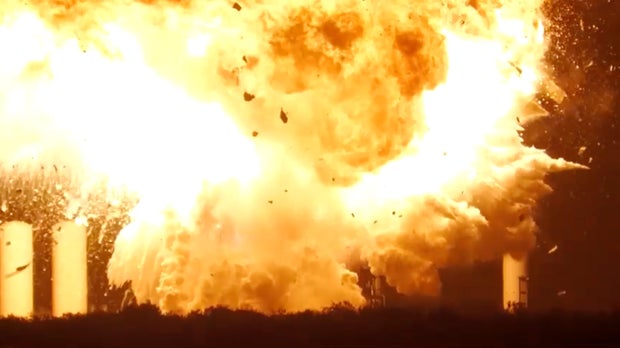SpaceX Starship upper stage explodes during ramp-up to expected engine test firing - CBS News
A SpaceX Starship upper stage exploded in a spectacular conflagration during ramp-up to an expected engine test firing at the company's Starbase manufacturing facility on the Texas Gulf Coast late Wednesday, destroying the rocket in what appears to be a major setback for the Super Heavy-Starship vehicle Elon Musk says is critical to the company's future.
Video from LabPadre, a company that monitors SpaceX activities at Starbase, showed the Starship suddenly exploding in a huge fireball just after 11 p.m. CDT, 10 to 15 minutes before the anticipated engine test firing, sending flaming debris shooting away into the overnight sky from a churning fireball that engulfed the test stand.
The video showed what appeared to be two major explosions, the first near the rocket's nose followed a moment later by a second eruption of flame and debris on the left side of the spacecraft. The test stand disappeared in a billowing fireball that rose into the overnight sky like a bomb blast.

The Starship was being filled with a full load of liquid oxygen and a partial load of high-energy methane fuel when the detonations occurred. Ninety minutes after the initial blast, fires appeared to still be burning out of control at what is known as the Massey test site, where cryogenic testing and hotfire tests are typically conducted.
"On Wednesday, June 18 at approximately 11 p.m. CT, the Starship preparing for the tenth flight test experienced a major anomaly while on a test stand at Starbase," SpaceX said in a statement on the social media platform X. "A safety clear area around the site was maintained throughout the operation and all personnel are safe and accounted for. Our Starbase team is actively working to safe the test site and the immediate surrounding area in conjunction with local officials.
"There are no hazards to residents in surrounding communities, and we ask that individuals do not attempt to approach the area."
The explosion's impact on the test site infrastructure was not immediately known. SpaceX has a history of making relatively quick recoveries from failures or setbacks but this mishap, along with destroying a nearly-ready-to-launch Starship, may have caused significant damage to Starbase infrastructure. In any case, the next test flight will be indefinitely delayed.
Known as Ship 36, SpaceX was expected to launch the Starship atop a huge Super Heavy booster around the end of the month on the integrated rocket's tenth unpiloted test fight. Hotfire tests are a normal precursor to actual flights, allowing engineers to verify upgrades and overall performance prior to committing it to launch.
SpaceX has launched nine Super Heavy-Starship test flights since April 2023. The first three flights ended with explosions or breakups that destroyed both stages.
The fourth, fifth and sixth test flights were partially successful, but two of the three most recent flights ended with Starship explosions before the spacecraft could reach its planned sub-orbital trajectory. The third, most recent flight on May 27 reached its planned trajectory but spun out of control and broke up during atmospheric entry.
NASA is counting on the giant rocket to launch a Starship variant carrying astronauts to a landing near the moon's south pole in the next two or three years.
To get the Human Landing System — HLS — Starship variant to the moon, SpaceX will need to launch 10 to 20 Super Heavy-Starships to refuel the lander in low-Earth orbit before it can head for the moon to await the arrival of the astronauts aboard a Lockheed Martin-built Orion crew capsule.
Given the complexity of the architecture, the need to launch multiple Super Heavy-Starships, perfect the autonomous transfer of super cold propellants and new technology to keep the cryogenic liquid methane and oxygen from warming up and boiling away in space, failures like Wednesday's will make the schedule all the tougher to meet.
Bill Harwood has been covering the U.S. space program full-time since 1984, first as Cape Canaveral bureau chief for United Press International and now as a consultant for CBS News.











